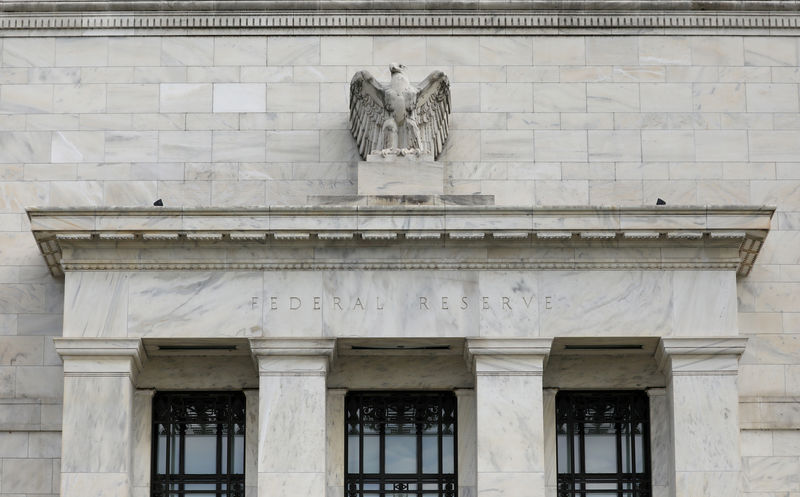

| 送交者: 色是空空是色[★★声望品衔10★★] 于 2019-10-11 14:56 已读 2321 次 1 赞 | 色是空空是色的个人频道 |
Fed launches Treasury bill buys in bid for 'ample' reservesEconomy7 minutes ago (Oct 11, 2019 03:47PM ET) 6park.com 4 6park.com 6park.com 6park.com ? Reuters. FILE PHOTO: The Federal Reserve building is pictured in Washington, DC By Jonnelle Marte
(Reuters) - The Federal Reserve said on Friday that it will start buying about $60 billion per month in Treasury bills to ensure "ample reserves" in the banking system, but emphasized the new program does not mark a change in monetary policy.
The purchases, which will begin Oct. 15, respond to recent disruptions in short-term money markets that pushed the target federal funds rate to the top of its target range, and at least once above it. The "technical" program, which Fed Chair Jerome Powell had signaled earlier this week was on its way, will continue at least until the second quarter of 2020, the central bank said.
The central bank also said it would continue to inject cash into overnight lending markets until January by offering daily operations in the market for repurchase agreements, or repos. But it said that the balance sheet expansion is meant to wean money markets off of the daily operations by bringing reserves to a level that accommodates economic growth but is also enough to absorb any spikes in demand.
But the size of the monthly Treasury purchases will be adjusted as the Fed learns more about how much liquidity is needed in the banking system.
AIMED AT RESERVES
The U.S. central bank began offering daily repo operations in mid-September after the repo rate, which is viewed as a measure of liquidity, spiked to 10% from about 2.25%. The daily operations are meant to ensure there are ample reserves available during spikes in demand.
Some investors said Friday's announcement is a sign that the Fed is willing to act as needed to stabilize short-term interest rates.
"The Fed will do whatever it needs to do to keep funding rates near where they want them," said Ward McCarthy, chief financial economist for Jefferies in New York. "If this proves to be insufficient they’ll simply do more."
Central bank officials anticipated they would one day need to resume expansion of the balance sheet to keep operating under a system of "ample reserves." Through that approach, the Fed sets monetary policy be controlling the interest rate charged on reserves instead of conducting daily market operations.
The Fed will initially aim to bring reserves to about $1.5 trillion, the level seen in early September, before a liquidity crunch led to a spike in short-term rates. But some strategists say the right level of reserves is between $1.6 trillion and $1.8 trillion.
NOT QUANTITATIVE EASING
U.S. President Donald Trump has been railing against Powell and his colleagues for months, demanding first that the Fed stop shrinking the balance sheet and more recently to ease monetary policy outright.
The U.S. central bank on Friday was at pains to emphasize that its new balance sheet operations were not a response to that call, and are entirely different from the trillions of dollars of Treasuries and mortgage-backed securities purchases it made during and after the financial crisis.
Those bond buys, known as quantitative easing, or QE, were designed to push down longer-term interest rates to spur borrowing and investment. The new purchases, of short-term bills, are simply meant to keep money markets operating smoothly.
They will therefore have “little if any” meaningful effect “on household and business spending decisions and the overall level of economic activity,” the Fed said, repeating that explanation three times for emphasis in a statement Friday accompanying its announcement.
Markets for the most part agreed.
Still, the spread between three-month (US3MT=RR) and 10-year yields (US10YT=RR), the Federal Reserve's preferred measure of the yield curve, on Friday widened by the most since May 7. The curve had been mostly inverted since May 22 before moving into positive territory on Friday.
While the improvement was mostly attributable to optimism about trade talks and Brexit, the Fed's announcement pushed the gap out further, delivering to Trump in practice if not intent at least some of what he wanted. The Fed stopped shrinking its balance sheet this summer, earlier than it had intended.
Across maturities, yields dipped modestly, but remained up between 5 and 10 basis points on the day.
Minneapolis Federal Reserve Bank President Neel Kashkari said earlier on Friday, before the Fed announced the details of the Treasury purchases, that reserves would have to grow to keep up with economic growth and changes in currency demand and regulatory requirements.
"We have to figure out what is the right growth rate of our balance sheet that is not about stimulating the economy, that is just about making sure there is enough liquidity in the system," he said.


